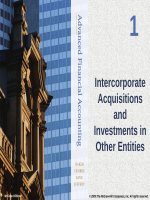Advanced financial accounting by baker chapter 05
Bạn đang xem bản rút gọn của tài liệu. Xem và tải ngay bản đầy đủ của tài liệu tại đây (3.42 MB, 40 trang )
5
Consolidation
of Less-thanWholly Owned
Subsidiaries
McGraw-Hill/Irwin
© 2009 The McGraw-Hill Companies, Inc. All rights reserved.
Effect of a Noncontrolling Interest
• When a subsidiary is less than wholly owned,
the consolidation procedures must be
modified slightly to recognize the
noncontrolling interest
5-2
Effect of a Noncontrolling Interest
• Consolidated Net Income
– In the absence of transactions between
companies included in the consolidation,
consolidated net income is equal to:
• The parent’s income from its own operations,
excluding any investment income from
consolidated subsidiaries, plus the net income
from each of the consolidated subsidiaries,
adjusted for any differential write-off
5-3
Effect of a Noncontrolling Interest
• The income attributable to the subsidiary
noncontrolling interest is deducted from
consolidated net income on the face of the
income statement to arrive at consolidated
net income attributable to the controlling
interest
– The income attributable to a noncontrolling
interest in a subsidiary is based on a
proportionate share of that subsidiary’s net
income
5-4
Effect of a Noncontrolling Interest
• Consolidated retained earnings
– That portion of the consolidated entity’s
undistributed earnings accruing to the parent’s
stockholders
– Calculated by adding the parent’s share of
subsidiary cumulative net income since
acquisition to the parent’s retained earnings
from its own operations and subtracting the
parent’s share of any differential write-off
5-5
Effect of a Noncontrolling Interest
• Consolidated retained earnings
– Retained earnings related to subsidiary
noncontrolling shareholders is included in the
Noncontrolling Interest amount reported in the
equity section of the consolidated balance
sheet
– More consistent with the parent company
theory rather than the entity approach
5-6
Illustration of consolidated net income
and consolidated retained earnings
Push Corporation acquires 80 percent of the stock of Shove Company for an
amount equal to 80 percent of Shove’s total book value. During 20X1, Shove
reports net income of $25,000, while Push reports net income of $120,000,
including equity-method income from Shove of $20,000 ($25,000 x .80).
Consolidated net income for 20X1 is computed and allocated as follows:
5-7
Illustration of consolidated net income
and consolidated retained earnings
Net income and dividends during the two years following acquisition are:
Consolidated retained earnings at December 31, 20X2, two years after the
date of combination, is computed as follows, assuming no differential:
5-8
Consolidated Balance Sheet with
Majority-Owned Subsidiary
On January 1, 20X1, Peerless acquires 80 percent of the common stock of
Special Foods for $310,000. At that date, the fair value of the noncontrolling
interest is estimated to be $77,500.
•
Peerless records the acquisition on its books with the following entry:
5-9
Consolidated Balance Sheet with
Majority-Owned Subsidiary
5-10
Consolidated Balance Sheet with
Majority-Owned Subsidiary
5-11
Workpaper for Consolidated Balance Sheet,
January 1, 20X1, Date of Combination;
80 Percent Acquisition at More than Book Value
5-12
Consolidated Balance Sheet with
Majority-Owned Subsidiary
5-13
Consolidated Financial Statements with
Majority-Owned Subsidiary
Continuing with the earlier illustration, with respect to the assets to which the
$87,500 differential relates, assume that all of the inventory is sold during
20X1, the buildings and equipment have a remaining economic life of 10 years
from the date of combination, and straight-line depreciation is used.
Assume that management determines at the end of 20X1 that the goodwill is
impaired and should be written down by $3,125.
Management has determined that the goodwill arising in the acquisition of
Special Foods relates proportionately to the controlling and noncontrolling
interests, as does the impairment. Assume that Peerless accounts for its
investment using the equity method.
5-14
Initial year of ownership
5-15
Initial year of ownership – Eliminating
Entries
5-16
Initial year of ownership – Eliminating
Entries
– Refer Figure 5-5 in the text for the equity-method workpaper for
consolidated financial statement
5-17
Noncontrolling Interest, 20X1
5-18
Consolidated Net Income and Retained
Earnings, 20X1
5-19
Second Year of Ownership
5-20
Second Year of Ownership
• Summary of changes in the parent’s investment
account for 20X1 and 20X2:
• The workpaper to prepare a complete set of
consolidated financial statements for the year 20X2
is illustrated in Figure 5–8 in the text
5-21
Second Year of Ownership
5-22
Noncontrolling Interest, 20X2;
80 Percent Acquisition at More than Book Value
5-23
Consolidated Net Income and Retained
Earnings, 20X2;
80 Percent Acquisition at More than Book Value
5-24
Discontinuance of Consolidation
• A parent should subsidiary from future
consolidation if the parent can no longer
exercise control over it
– If a parent loses control of a subsidiary and no
longer holds an equity interest in the former
subsidiary, it recognizes a gain or loss for the
difference between any proceeds received from
the event leading to loss of control and the
carrying amount of the parent’s equity interest
5-25









